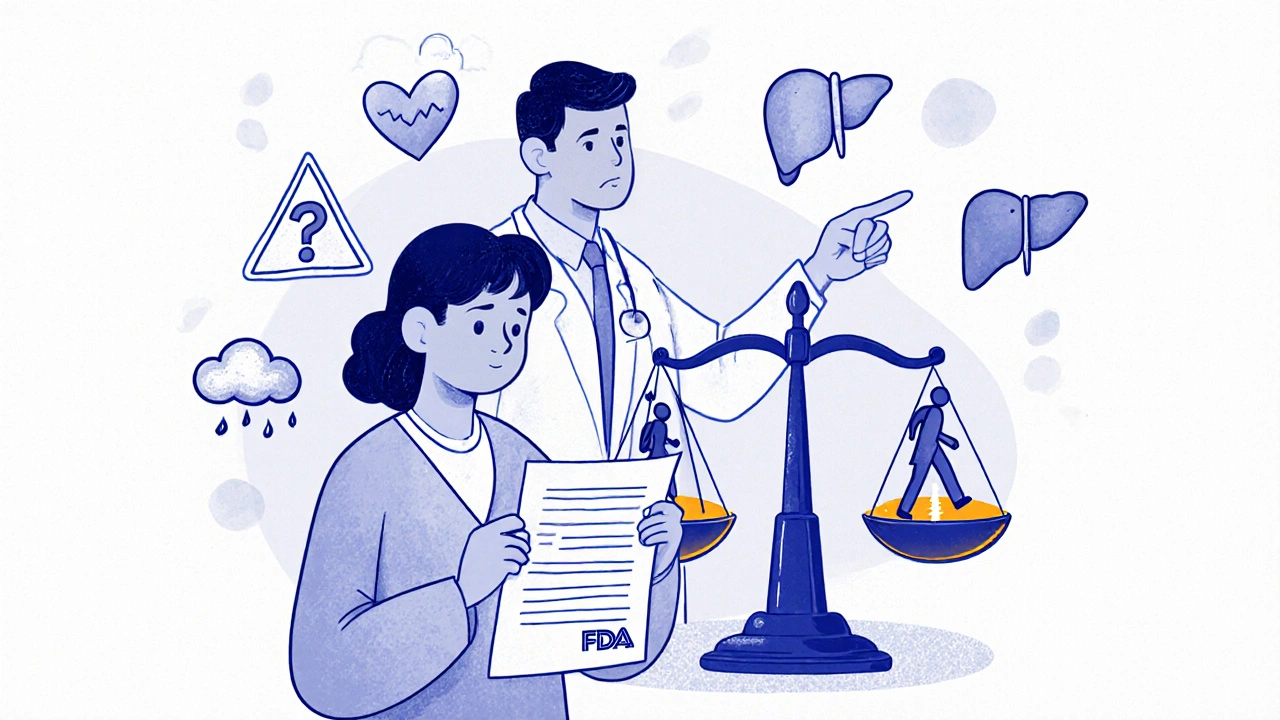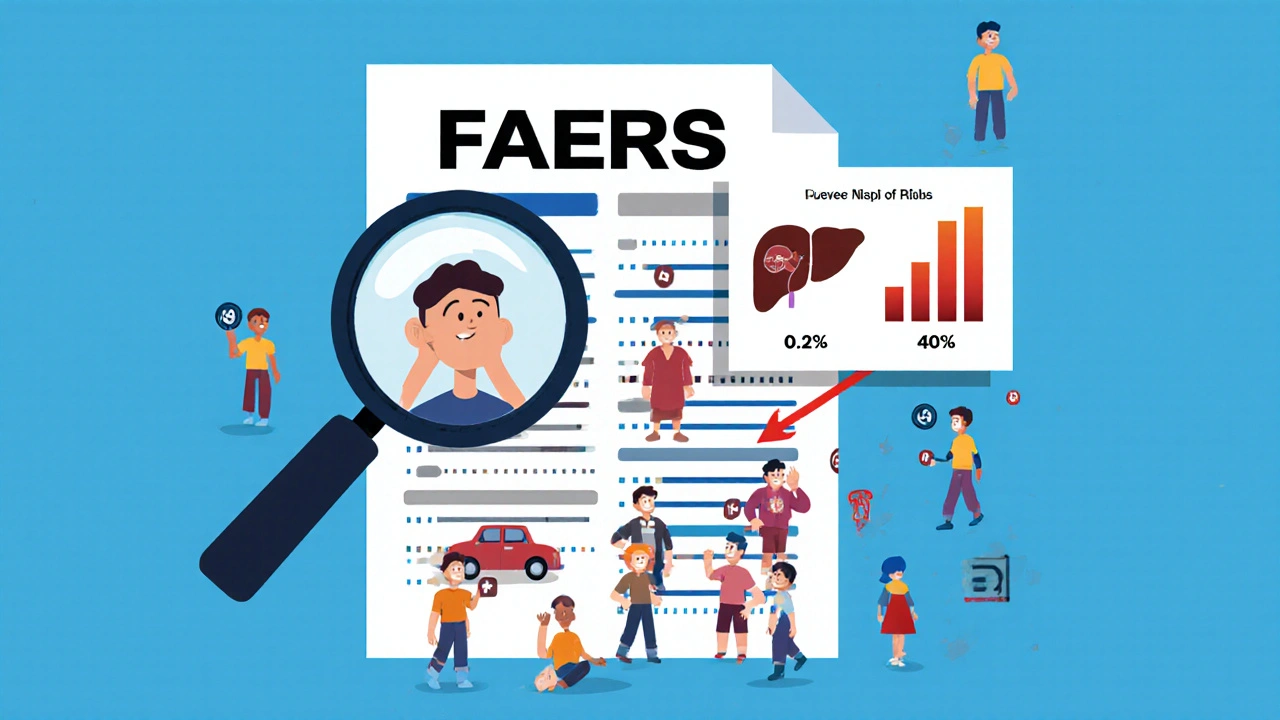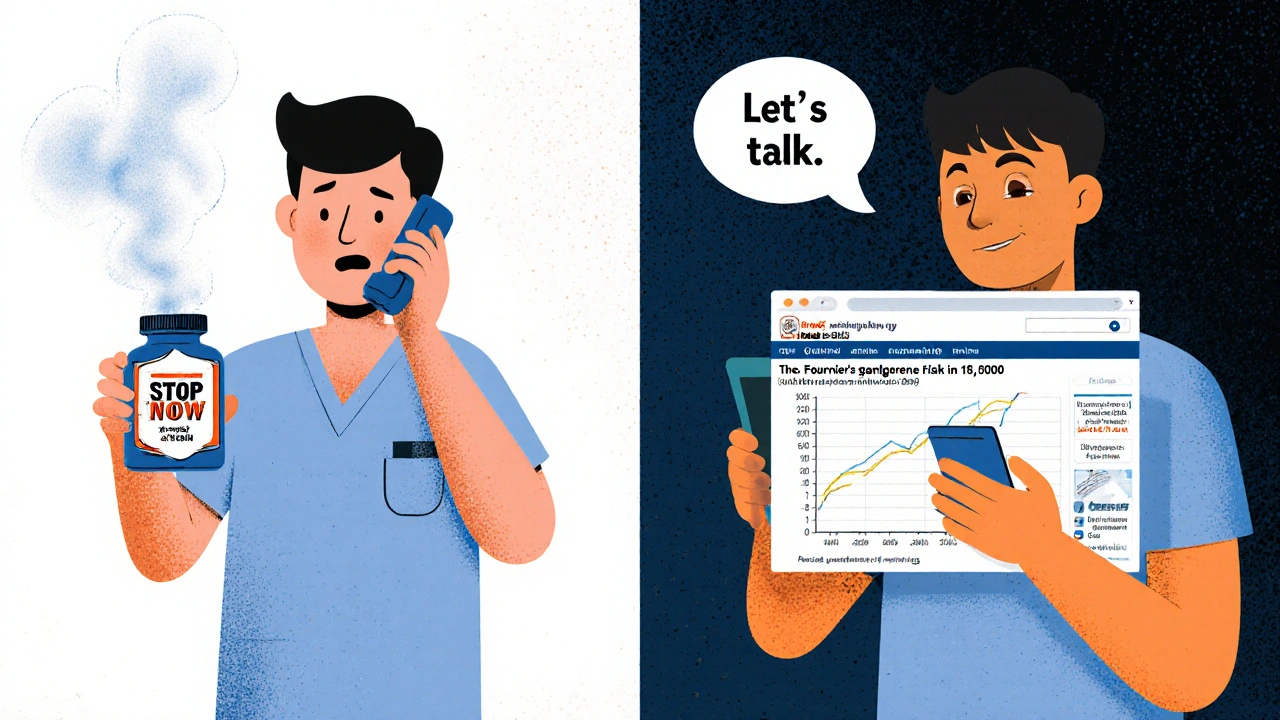How to Interpret Risk vs. Benefit in FDA Safety Announcements
 Nov, 19 2025
Nov, 19 2025
When you see an FDA safety alert about your medication, it’s natural to panic. Did your doctor prescribe something dangerous? Should you stop taking it right away? The truth is, most FDA safety announcements don’t mean your drug is unsafe-they mean the agency is watching closely. Understanding the difference between a risk and a benefit in these alerts can save you from unnecessary fear, and even save your life.
What the FDA Actually Means by "Potential Signal"
The FDA doesn’t wait for proof to act. It looks for patterns. If 15 people report a rare liver injury after taking a drug, and no one else taking other drugs reports that same injury, that’s a potential signal. But a signal isn’t proof. It’s a red flag that says: "We need to look deeper." The FDA’s FAERS database holds over 25 million adverse event reports. Most of them are incomplete. Someone might report "headache" after taking a pill-but they also had the flu, took ibuprofen, and didn’t sleep for three days. The FDA doesn’t assume the drug caused it. They look for statistical imbalances across thousands of reports.When you read an FDA Drug Safety Communication that says "potential signal," it means exactly that: possible, not proven. The agency is clear: "This does not mean FDA has determined that the drug has the risk." Yet many patients hear "FDA warns of liver damage" and assume the drug is dangerous. That’s where interpretation fails.
Benefit Isn’t Just About Feeling Better
People often think benefit means "relief from symptoms." But in drug safety, benefit is deeper. It’s about preventing death, hospitalization, or permanent disability. A drug for high blood pressure might cause a dry cough-that’s an annoyance. But if it cuts your risk of stroke by 40%, the benefit outweighs the cough.Take diabetes medications. Some carry a small risk of a rare genital infection. But for a patient with heart disease and uncontrolled blood sugar, the benefit of preventing a heart attack or kidney failure is far greater than the 0.1% chance of infection. The FDA doesn’t judge drugs in a vacuum. They ask: "What happens if this patient doesn’t take it?" A 2022 FDA analysis found that 65% of safety alerts led to labeling changes-not because the drug was pulled, but because the benefit-risk balance needed clearer explanation. For example, a drug for rheumatoid arthritis might now say: "Use with caution in patients with active infections." That’s not a warning to stop. It’s a guide to use it smarter.
How to Read an FDA Alert Like a Doctor
Most patients read FDA alerts like news headlines. Doctors read them like lab results. Here’s how to do the same:- Check if it’s a "potential signal" or "confirmed risk." Only 58% of alerts make this clear. If it doesn’t say "confirmed," assume it’s still under review.
- Look for numbers. The best alerts give you risk numbers. For example: "Fournier’s gangrene occurred in 0.2 cases per 1,000 patient-years." That’s about 1 in 5,000 people over five years. Compare that to the risk of uncontrolled diabetes-which can lead to amputation in 1 in 10 people over the same time.
- Ask: Is this a new risk? The FDA only acts on information that emerged after approval. If the risk was already in the label, it’s not new. It’s just being reinforced.
- Check if it applies to you. A risk for pregnant women doesn’t matter if you’re a 65-year-old man. A risk for people with kidney disease doesn’t apply if your kidneys are healthy.
- Don’t stop the drug unless told. The FDA explicitly says: "FDA is not suggesting you stop taking the medication." Stopping abruptly can be more dangerous than the risk itself.
One physician on Reddit shared that after an alert about SSRIs and pregnancy, 12 of his patients called asking to stop their meds. None of them knew the absolute risk increase was 0.5%-from 1.5% to 2%. Meanwhile, untreated depression during pregnancy raised the risk of preterm birth by 30%. The benefit of staying on the drug was far greater.

Why Some Alerts Cause More Confusion Than Clarity
The FDA’s biggest flaw isn’t science-it’s communication. Many alerts don’t include context. A 2022 survey found that 68% of doctors felt FDA alerts lacked enough information to judge real risk.Take the 2021 alert about menstrual changes after the COVID-19 vaccine. The FDA flagged reports of irregular periods. But they didn’t say: "This happened in 0.3% of women under 40," or "This is similar to stress-induced changes seen after illness." The result? Panic. Later, studies showed these changes were temporary and didn’t affect fertility.
Compare that to the August 2022 alert on SGLT2 inhibitors for diabetes. It said: "Fournier’s gangrene risk is 0.2 per 1,000 patient-years. Baseline risk in non-users is 0.06." That’s a clear, measurable comparison. Patients and doctors could weigh it. That’s the gold standard.
What to Do When You See an Alert
You don’t need to be a doctor to interpret this right. Here’s your action plan:- Don’t panic. The FDA is not telling you to stop. They’re telling you to be informed.
- Check the date. Is this a 2024 alert or a 2018 one? Newer alerts reflect better data.
- Search for the drug’s current label. Go to [email protected] and look up the prescribing information. The "Warnings and Precautions" section will tell you what’s confirmed.
- Call your prescriber. Ask: "Does this apply to me? What’s the actual risk? Is there a better alternative?" Most doctors welcome this question.
- Report your experience. If you have an unusual side effect, report it to MedWatch. Your report helps the FDA see patterns faster.
One patient with multiple sclerosis told her neurologist she’d been having dizziness after starting a new drug. The doctor checked the FDA alert-there was a potential signal for dizziness. But the patient’s symptoms started after changing her sleep schedule. They adjusted her routine, not her meds. That’s how good interpretation works.

The Bigger Picture: Why This System Exists
Clinical trials involve 3,000 to 5,000 people. Real life has millions. A rare side effect might only show up after 100,000 people take a drug. That’s why the FDA keeps watching. It’s not about catching every mistake-it’s about catching the ones that matter.The FDA’s system isn’t perfect. It’s slow. It’s noisy. But it’s the best we have. The alternative? Drugs pulled off the market after hundreds of deaths because no one was watching.
Today, the FDA is working to fix its communication. By 2025, they plan to use standardized risk numbers in every alert. By 2026, they’ll launch a tool that lets patients visualize risk vs. benefit in simple charts. That’s progress.
For now, your job isn’t to trust or fear the FDA. It’s to understand what the data really says-and make a decision based on facts, not fear.
Should I stop taking my medication if the FDA issues a safety alert?
No, unless your doctor tells you to. FDA safety alerts, especially those labeled as "potential signals," are not instructions to stop taking your medicine. The FDA explicitly states that these alerts do not mean the drug is unsafe or that you should discontinue use. Stopping medication abruptly can lead to serious health consequences, such as worsening of your condition, withdrawal symptoms, or rebound effects. Always consult your healthcare provider before making any changes to your treatment plan.
What’s the difference between an adverse event and an adverse drug reaction?
An adverse event is any unwanted medical occurrence that happens while you’re taking a drug-whether or not the drug caused it. It could be a headache, nausea, or even a car accident that happened the same day you took your pill. An adverse drug reaction (ADR), on the other hand, is when there’s a reasonable possibility that the drug actually caused the problem. The FDA uses clinical and statistical analysis to determine if an event is likely an ADR. Only ADRs are used to assess true risk.
How does the FDA decide if a drug’s benefits outweigh its risks?
The FDA uses a structured framework with six key elements: the severity of the condition being treated, available alternative treatments, how strong the drug’s benefit is, how often and how serious the side effects are, whether the risks can be managed (like with monitoring or special instructions), and what patients say about their experience. For life-threatening conditions like cancer or advanced heart disease, higher risks may be acceptable if the benefit is significant. For mild conditions like occasional allergies, even small risks may be too much.
Why do some FDA alerts seem to contradict each other?
They don’t contradict-they reflect evolving evidence. A drug might get an alert for a rare side effect based on early reports, then later be cleared after more data shows the risk is extremely low or only applies to certain groups. For example, early reports linked a diabetes drug to pancreatitis, but later studies with larger populations showed no increased risk. The FDA updates its communications as new information becomes available. What looks like a contradiction is actually the system working as intended: learning over time.
Can I trust FDA safety alerts if they’re based on patient reports?
Yes-but with context. The FDA doesn’t rely on patient reports alone. They use them as a starting point. Each report is reviewed alongside clinical data, scientific literature, and statistical analysis from millions of other reports. A single report of a rare side effect doesn’t trigger an alert. It’s the pattern across many reports that raises concern. Patient reports are vital because they catch things clinical trials miss-like side effects in older adults, pregnant women, or people taking multiple medications. But they’re just one piece of the puzzle.
What should I do if my doctor ignores an FDA safety alert?
If your doctor dismisses an alert without explanation, ask for specifics: "What does the data show? Is this risk confirmed? Does it apply to me?" A good doctor will welcome the conversation. If they still don’t provide a clear answer, consider seeking a second opinion. You have the right to understand why a treatment is right for you. Don’t be afraid to ask for the evidence behind their decision. The FDA’s alerts are tools for informed care-not mandates.

Ellen Calnan
November 20, 2025 AT 01:17God, I remember when my mom got that alert about her blood pressure med-she nearly threw the whole bottle out the window. Turned out the "risk" was a 0.03% chance of a rash that looked like a sunburn. Meanwhile, she’d had two mini-strokes in two years. She didn’t stop. She called her doctor. He said, "You’re not dying from the rash. You’re dying if you stop." That’s the difference between fear and fact.
People treat FDA alerts like doom scrolls. They’re not. They’re breadcrumbs. Follow them to the label, not to the panic button.
Andrew Montandon
November 20, 2025 AT 14:25STOP. RIGHT. NOW. If you see "potential signal" and you’re thinking "I should quit," you’re doing it wrong. The FDA doesn’t say "stop" unless it’s a confirmed, life-threatening, no-doubt-about-it situation-and even then, they usually say "consult your doctor."
My cousin quit her antidepressant after an alert about weight gain. She had a breakdown. She was in the ER. The risk? 12% chance of gaining 10 lbs. The consequence? She lost 3 years of stability. Don’t be that person.
Dion Hetemi
November 22, 2025 AT 09:12Let’s be real-the FDA is a bureaucratic mess. They flag everything. A kid in Ohio says he got a headache after taking metformin? That’s a "potential signal." Meanwhile, 500,000 people die from heart disease every year because they don’t take their meds. The system is designed to scare people, not inform them. And it works. That’s why Big Pharma loves it-more lawsuits, more fear, more profits.
Michael Petesch
November 23, 2025 AT 14:05While the article correctly emphasizes statistical literacy, it underestimates the psychological burden these alerts impose on patients. Even when the data is clear, the language used-"potential signal," "rare association," "case reports"-triggers the availability heuristic. People remember the one story about the woman who lost her leg, not the 99,999 who didn’t.
Health communication needs to evolve beyond dry percentages. We need visual risk comparators-like showing the chance of Fournier’s gangrene next to the risk of being struck by lightning. Context isn’t just helpful; it’s essential.
river weiss
November 25, 2025 AT 10:09One thing the FDA doesn’t do well: explain what "patient-years" means. I’ve seen patients stare at "0.2 per 1,000 patient-years" like it’s ancient Greek. It means: if 1,000 people take the drug for one year, you’d expect 0.2 cases. Or if 100 people take it for 10 years, still 0.2 cases. That’s less than one in five thousand over a decade.
Compare that to driving to work: your risk of dying in a car crash on a 20-minute commute is about 1 in 10,000 per year. You drive anyway. Why? Because you weigh it. That’s what we need to teach people: not to fear the drug, but to weigh the risk.
Sam Reicks
November 25, 2025 AT 23:12the fda is just a front for big pharma. they let drugs get approved then wait for people to die so they can slap a warning on it and make more money off the lawsuits. you think they care about you? they care about liability. that's why they wait. if they acted fast, they'd have to recall drugs and lose billions. this whole system is rigged. i know people who died from these meds and no one said a word until it was too late.
Brian Rono
November 27, 2025 AT 20:12Let me guess-you’re one of those people who thinks "FDA alert" means "danger"? Please. Half of these alerts are triggered by a single Reddit post and a typo in a medical form. I’ve seen a "potential signal" for flatulence after taking ibuprofen. That’s not science. That’s noise. The FDA needs to stop treating every anecdote like a Nobel Prize-worthy discovery. You’re not a scientist. You’re a data point with a smartphone.
seamus moginie
November 29, 2025 AT 04:37My grandad was on a statin. Got the alert about muscle pain. He stopped cold turkey. Two weeks later-he had a heart attack. He didn’t know the risk of stopping was 20x higher than the risk of the side effect. He trusted the headline, not the doctor. I still blame myself. If I’d known then what I know now…
Don’t be my grandad. Talk to someone who knows the numbers. Not the internet. Not the news. Someone who’s seen 10,000 patients.
Derron Vanderpoel
November 29, 2025 AT 21:30I took my anxiety med for 8 years. Then the FDA dropped an alert about weight gain. I panicked. I quit. I gained 40 pounds. I got worse. My anxiety spiked. I ended up in therapy. Turns out the weight gain was mild for most people, and my doctor said the risk of relapse without the med was 70%. I’m back on it now. I wish I’d known the numbers before I ruined my life over a headline.
Kara Binning
November 30, 2025 AT 07:33AMERICA IS BEING POISONED. The FDA is a puppet of the pharmaceutical oligarchs. They let deadly drugs stay on the market for years-while they patent the next one. You think they care about your liver? They care about your insurance co-pay. They want you addicted. They want you dependent. They want you terrified so you keep buying. This isn’t science-it’s a money machine. And you’re the fuel.
Richard Risemberg
November 30, 2025 AT 21:51Look-I’ve been on six different meds for my autoimmune stuff. Every time there’s an alert, I do the same thing: I pull up the label. I read the "Warnings" section. I Google the exact phrase "FDA [drug name] risk benefit analysis"-and I find the white papers. I don’t trust headlines. I trust data.
One alert said my drug might cause pancreatitis. I checked: 0.08% over five years. My risk of untreated lupus? 40% chance of kidney failure. So I kept taking it. I’m still here. The drug didn’t kill me. The disease would have.
Joe Durham
December 1, 2025 AT 05:53My sister is a nurse. She told me something I’ll never forget: "Patients who panic and quit their meds after an alert are the ones who end up back in the hospital-not the ones who keep taking them."
It’s not about being brave. It’s about being smart. The FDA isn’t your enemy. Fear is. Take a breath. Talk to your doctor. Read the label. You’ve got this.
Dana Dolan
December 1, 2025 AT 07:03i just read this and i’m like… why is everyone so scared? i mean, i get it. meds are scary. but like… the fda doesn’t just yell "DANGER" for fun. they’re trying to help. maybe they’re slow. maybe they’re messy. but they’re the only thing keeping us from a world where every drug is a russian roulette. so… yeah. read the label. talk to your doc. don’t be a drama llama.
Zac Gray
December 1, 2025 AT 18:14Let me tell you about the time I saw an alert about my blood thinner. I called my doctor. He said, "It’s a signal. Not a verdict. Here’s the data: 1 in 10,000 chance of bleeding. Your chance of a stroke without it? 1 in 3 over the next 5 years. So… you want to gamble?"
I didn’t stop. I didn’t panic. I just asked the right question: "What happens if I don’t take it?" That’s the only question that matters.
And honestly? If you’re reading an FDA alert and not asking that, you’re not being cautious-you’re being lazy. The system gives you the tools. You just have to use them. Don’t outsource your health to a headline.